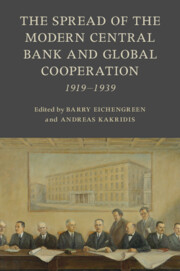Book contents
- The Spread of the Modern Central Bank and Global Cooperation
- Studies in Macroeconomic History
- The Spread of the Modern Central Bank and Global Cooperation
- Copyright page
- Contents
- Figures
- Tables
- Editors and Contributors
- Preface
- Part I General
- Part II Specific
- 5 Central Bank Policy under Foreign Control
- 6 Sneaking Nationalization
- 7 The Bank of Poland and Monetary Policy during the Interwar Period
- 8 From Banking Office to National Bank
- 9 ‘Nobody’s Child’
- 10 The Bulgarian National Bank, 1926–1935
- 11 Macroeconomic Policies and the New Central Bank in Turkey, 1929–1939
- 12 Latin American Experiments in Central Banking at the Onset of the Great Depression
- 13 Central Banks in the British Dominions in the Interwar Period
- 14 Central Banking and Colonial Control
- Index
- References
13 - Central Banks in the British Dominions in the Interwar Period
from Part II - Specific
Published online by Cambridge University Press: 02 November 2023
- The Spread of the Modern Central Bank and Global Cooperation
- Studies in Macroeconomic History
- The Spread of the Modern Central Bank and Global Cooperation
- Copyright page
- Contents
- Figures
- Tables
- Editors and Contributors
- Preface
- Part I General
- Part II Specific
- 5 Central Bank Policy under Foreign Control
- 6 Sneaking Nationalization
- 7 The Bank of Poland and Monetary Policy during the Interwar Period
- 8 From Banking Office to National Bank
- 9 ‘Nobody’s Child’
- 10 The Bulgarian National Bank, 1926–1935
- 11 Macroeconomic Policies and the New Central Bank in Turkey, 1929–1939
- 12 Latin American Experiments in Central Banking at the Onset of the Great Depression
- 13 Central Banks in the British Dominions in the Interwar Period
- 14 Central Banking and Colonial Control
- Index
- References
Summary
The interwar decades saw the emergence of central banking institutions in the prosperous white settler ‘dominions’ of Australia, South Africa, New Zealand, and Canada. Local political and business interests promoted central banks with a view to fostering domestic economic and financial stability, while the Bank of England and British government imagined a chain of central banks across the empire that would support their policies. Given that financial markets in the dominions were underdeveloped, it was difficult for the new central banks control monetary conditions, mirroring problems in Central and Eastern Europe. In addition, the British discovered that they could not impose their ideas on the dominions, especially when local economic concerns conflicted with those of the imperial centre.
Keywords
- Type
- Chapter
- Information
- The Spread of the Modern Central Bank and Global Cooperation1919–1939, pp. 352 - 382Publisher: Cambridge University PressPrint publication year: 2023



